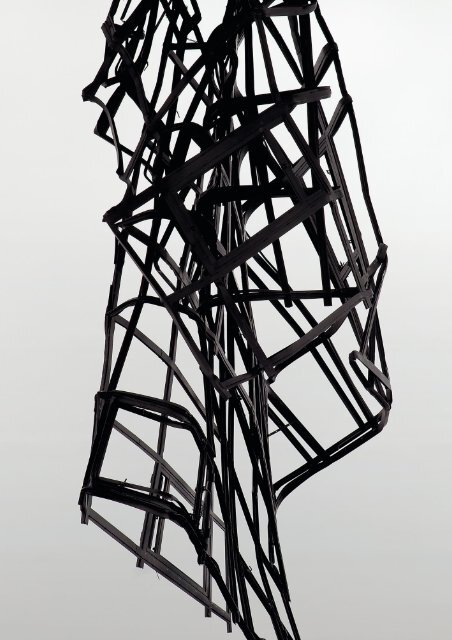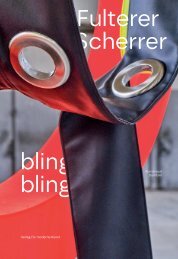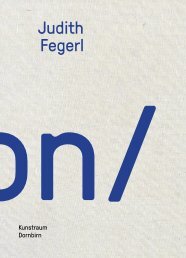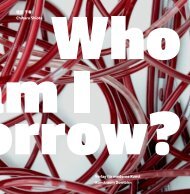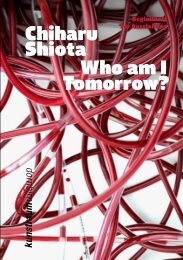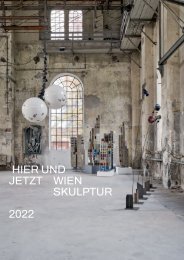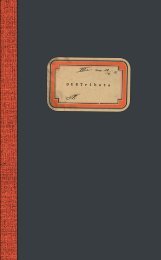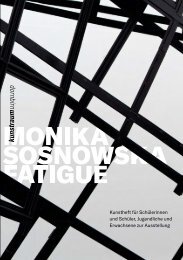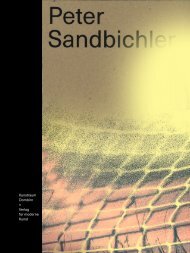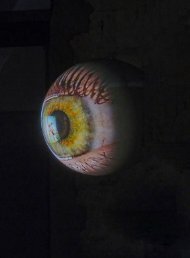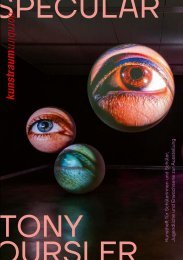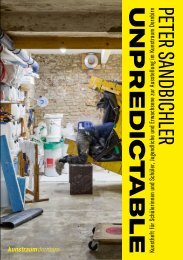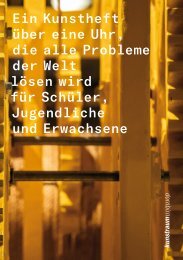Katalog: Monika Sosnowska "Fatigue"
Der Katalog erscheint anlässlich der Ausstellung "Fatigue" der polnischen Künstlerin Monika Sosnowska im Oktober 2022.
Der Katalog erscheint anlässlich der Ausstellung "Fatigue" der polnischen Künstlerin Monika Sosnowska im Oktober 2022.
- Keine Tags gefunden...
Sie wollen auch ein ePaper? Erhöhen Sie die Reichweite Ihrer Titel.
YUMPU macht aus Druck-PDFs automatisch weboptimierte ePaper, die Google liebt.
Preface<br />
Thomas Häusle<br />
Director<br />
Kunstraum Dornbirn<br />
The Japanese term shibumi describes and celebrates simple, subtle<br />
beauty, or the quality in general that elegantly and seemingly without<br />
any effort brings complexity and simplicity into harmony. Simplicity<br />
in this sense, however, never means ignorance or banality; on the<br />
contrary, simplicity and clarity are achieved only by passing through<br />
knowledge, complexity and toil. This particular quality is embodied<br />
to perfection in works of <strong>Monika</strong> Sosnoswka.<br />
A steel beam deformed into an L and leaning almost arbitrarily<br />
against the wall; rebars seemingly spat out by the wall; a huge sewage<br />
pipe, torn like a sheet of paper, lying lightly and matter-of-factly<br />
on the floor; and finally, the façade of a legendary gallery in Warsaw,<br />
which hangs on a single steel cable, like a cloth napkin casually<br />
picked up in the middle, almost floating and completely occupying<br />
the space: these demonstrate this quality, fascinatingly light and<br />
yet weighing tons.<br />
Can we imagine that the process of deforming the façade, of<br />
bending, tearing, ripping and squeezing took three months until<br />
the desired, planned form, lightness and, somehow, naturalness<br />
of the work could at last be attained? And how is it even possible<br />
to tear a massive steel tube like a sheet of paper? What lies behind<br />
the reinforcing steel hanging down from the wall in bundles? We<br />
can ask ourselves these questions, but we don’t have to. If we do<br />
pose them, however, they lead us deeper into the world of <strong>Monika</strong><br />
<strong>Sosnowska</strong>.<br />
In their beginnings, <strong>Sosnowska</strong>’s works are the often not really<br />
planned symbiosis of an idea, originating from the enduring and<br />
determining interest in architecture and transformation, with an<br />
inspiration from the environment, politics or society. Formative for<br />
<strong>Sosnowska</strong> were the transformation of her homeland, Poland, from<br />
communism to capitalism and its consequences for life, society<br />
and very strongly architecture in the country. Facade tells directly<br />
of this, for the façade of the Warsaw gallery had to make way for a<br />
more modern, functional one.<br />
A model is then the next step in the genesis of <strong>Sosnowska</strong>’s<br />
work. A model that is brought into shape with, in the truest sense<br />
of the word, tremendous effort. The original object is completely<br />
divested of its function; in the end, it can be used for exactly nothing<br />
save to be art, to tell stories, to show, to be transformed, and also<br />
to please us. For it is pleasing the way that the steel girder leans<br />
against the wall almost coquettishly and casually and, on closer<br />
inspection, develops a fascinating spatial effect and presence, the<br />
power and space-dominating impact which can be developed by<br />
an apparently light mesh floating from the ceiling which yet weighs<br />
1.3 tonnes: the transformation of the objects into the dysfunctional,<br />
the absurd, the ironic.<br />
A big thank-you goes of course to <strong>Monika</strong> <strong>Sosnowska</strong> for her<br />
great commitment to the project, but likewise to Roland Adlassnigg<br />
for managing the production, Stefan Amann and Martin Platzgummer<br />
for the graphic design, Sina Wagner for publication and communication<br />
and Patricia Janisch for the back office. I would also like<br />
to express my gratitude to our patrons and sponsors: the City of<br />
Dornbirn, the Province of Vorarlberg, BMKOES, Sparkasse Dornbirn<br />
and proxi.me. And finally many thanks to the lenders Hauser &<br />
Wirth, the Museum of Modern Art in Warsaw and the Foksal Gallery<br />
Foundation in Warsaw for their trusting cooperation.<br />
2<br />
3<br />
Einfach ist oft einfach gut!<br />
Thomas Häusle<br />
Direktor<br />
Kunstraum Dornbirn<br />
Der japanische Begriff Shibumi beschreibt und feiert die einfache,<br />
subtile Schönheit oder überhaupt die Eigenschaft, welche elegant<br />
und scheinbar mühelos Komplexität und Einfachheit in Einklang<br />
bringt. Einfachheit bedeutet in diesem Sinne aber niemals Unwissenheit<br />
oder Banalität, vielmehr werden dabei Wissen, Komplexität<br />
und Mühsal durchmessen, um in der Einfachheit und Klarheit<br />
anzukommen. Diese besondere Qualität repräsentieren <strong>Monika</strong><br />
<strong>Sosnowska</strong>s Werke in Perfektion.<br />
Ein beinahe beliebig an die Wand gelehnter, zu einem L verformter<br />
Stahlträger, Bewehrungsstäbe die von der Wand scheinbar<br />
ausgespuckt werden, ein riesiges Abwasserrohr, das wie ein Blatt<br />
Papier zerrissen, leicht und flüchtig am Boden liegt, und schließlich<br />
die Fassade einer legendären Galerie in Warschau, die einer<br />
beiläufig in der Mitte aufgehobenen Stoffserviette gleich an einem<br />
einzigen Stahlseil hängend, fast schwebend den Raum ganz und<br />
gar in Anspruch nimmt, belegen diese Qualität faszinierend leicht<br />
und doch tonnenschwer.<br />
Können wir uns vorstellen, dass der Prozess des Verformens<br />
der Fassade, des Biegens, Zerrens, Reißens und Quetschens, drei<br />
Monate gedauert hat, bis endlich die gewünschte, geplante Form,<br />
Leichtigkeit und irgendwie Selbstverständlichkeit des Werkes erreicht<br />
werden konnte? Und wie ist es möglich, ein massives Stahlrohr<br />
mal eben zu zerreißen wie ein Blatt Papier? Was steckt alles hinter<br />
dem aus der Wand gebündelt herabhängenden Armierungsstahl?<br />
Das können wir uns fragen, müssen wir aber nicht. Tun wir es doch,<br />
führt es uns tiefer in die Welt der <strong>Monika</strong> <strong>Sosnowska</strong>.<br />
<strong>Monika</strong> <strong>Sosnowska</strong>s Arbeiten sind am Anfang die oft nicht<br />
wirklich geplante Symbiose aus einer Idee, entsprungen dem<br />
dauerhaften und bestimmenden Interesse an Architektur und<br />
Transformation, sowie einer Inspiration aus Umwelt, Politik und/oder<br />
Gesellschaft. Prägend für die Künstlerin waren die Transformation<br />
ihrer Heimat Polen vom Kommunismus zum Kapitalismus und die<br />
Folgen für das Leben, die Gesellschaft und auch stark die Architektur<br />
in dem Land. „Facade“ erzählt direkt davon, denn die Fassade der<br />
Galerie musste einer moderneren, funktionsfähigeren weichen.<br />
Ein Modell ist dann der nächste Schritt in der Genese von <strong>Sosnowska</strong>s<br />
Arbeiten. Ein Modell, das anschließend mit – im wahrsten<br />
Sinne des Wortes – gewaltigem Aufwand traktiert in Form gebracht<br />
wird. Der ursprüngliche Gegenstand wird dabei vollständig seiner<br />
Funktion beraubt – er ist am Ende zu exakt nichts mehr zu gebrauchen,<br />
außer Kunst zu sein, zu erzählen, zu zeigen, transformiert<br />
zu sein und auch uns zu gefallen.<br />
Gefallen kann, dass der Stahlträger fast schon kokett beiläufig<br />
an der Wand lehnt und bei näherer Betrachtung eine faszinierende<br />
Raumwirkung und Präsenz entwickelt; welche Kraft und raumbeherrschende<br />
Wirkung ein vermeintlich leichtes von der Decke<br />
schwebendes Geflecht entwickeln kann, das doch 1,3 Tonnen<br />
wiegt; oder die Transformation der Gegenstände ins Dysfunktionale,<br />
Absurde, Ironische.<br />
Großer Dank für großes Engagement gilt selbstverständlich<br />
<strong>Monika</strong> <strong>Sosnowska</strong>, aber auch Roland Adlassnigg für die Leitung<br />
der Produktion, Stefan Ammann und Martin Platzgummer für das<br />
Grafikdesign, Sina Wagner für Publikation und Kommunikation<br />
sowie Patricia Janisch für das Backoffice. Danken möchte ich<br />
unseren Fördergebern und Sponsoren – Stadt Dornbirn, Land<br />
Vorarlberg, BMKOES, Sparkasse Dornbirn, proxi.me. Großer<br />
Dank gilt den Leihgebern Hauser & Wirth, Museum of Modern Art<br />
in Warschau und der Foksal Gallery Foundation in Warschau für<br />
die vertrauensvolle Zusammenarbeit.
4<br />
5
Stach Szabłowski<br />
In the exhibition space of Kunstraum Dornbirn, which was once<br />
an industrial factory hall, I look at <strong>Monika</strong> <strong>Sosnowska</strong>’s titanic<br />
steel sculptures and it seems to me I can hear an echo of a<br />
memorable key line uttered in Franklin J. Schaffner’s movie<br />
Planet of the Apes: “The question is not so much where we<br />
are as when we are”.<br />
In Planet of the Apes astronauts from the Earth find themselves<br />
in a world where an alternative evolutionary scenario<br />
has been enacted. In this scenario, the roles of apemen and<br />
manapes have been distributed inversely to the reality that<br />
we all know. It is the man-resembling primates (hominidae)<br />
who articulated language, produced culture and technology,<br />
and built civilization. Human beings (homo) find themselves<br />
beyond the pale; they don’t have the status of a person along<br />
with all associated statutory laws; they are the counterpart of<br />
what anthropocentric culture calls an “animal”.<br />
Thus degraded, the astronauts wonder what kind of reality<br />
they have ended up in. Where could this world, so similar to<br />
ours, and at the same time so different, possibly be located?<br />
They will discover the answer only after finding out that, instead<br />
of travelling in space, they have travelled in time.<br />
Is it the same when we view <strong>Sosnowska</strong>’s exhibition in<br />
Dornbirn, near the border between Switzerland and Austria, in<br />
the very heart of Old Europe? Do we visit this exhibition after<br />
the end of history? Or after the end of modernity? After the Industrial<br />
Age? After the fall of the Berlin Wall? After all illusions<br />
have been finally shattered? Waiting for a turning point to come?<br />
Sensing possible catastrophe?<br />
The exhibition is entitled Fatigue. Thus we should pose two<br />
further questions to all those that were asked before: Who suffers<br />
from fatigue? What is fatigued and fatigued of what exactly?<br />
Before we start searching for answers to these questions,<br />
following the paths proposed by <strong>Sosnowska</strong>, let us take a look<br />
at the exhibition itself. Kunstraum Dornbirn is a space endowed<br />
with the charm appropriate to post-industrial objects, which<br />
After, that is, before<br />
<strong>Monika</strong> <strong>Sosnowska</strong>’s sculptures<br />
at Kunstraum Dornbirn<br />
has been adopted as an art exhibition space. The particular<br />
expressive nature of such spaces results from their raw simplicity,<br />
which is not artificial and staged as in the case of white cubes<br />
art galleries, but sincere and convincing, as is anything that is<br />
functional. Such spaces bring their former identity to the art<br />
discourse and exercise an allegorical appeal; after all, it is not<br />
irrelevant whether the space in which we view art is a palace,<br />
an aseptic laboratory, or a factory.<br />
At Kunstraum Dornbirn, the former identity of the exhibition<br />
space voices itself in a particularly eloquent manner. Under the<br />
ceiling of the hall there is still a system of swivel arms with chain<br />
hoists ready to move heavy loads, the smell of the grease from<br />
the machines that used to operate here still lingers in the air.<br />
In such scenery, <strong>Sosnowska</strong>’s works seem to feel at home,<br />
as if they were site-specific installations designed specifically for<br />
Kunstraum Dornbirn spaces – although, in reality, they are sculptures<br />
that originated somewhere else and in different contexts.<br />
Fatigue shows four sculptures, all of them made of structural<br />
steel elements used in the construction industry. It is not difficult<br />
to imagine that similar elements could have been forged and<br />
modelled in a place such as the former workshop hall which is<br />
today’s Kunstraum Dornbirn.<br />
It is equally possible to imagine another scenario: production<br />
activity has terminated a long time ago, but the transformation<br />
process of the produced elements did not come to an end; steel<br />
forms continue to morph, or even mutate, now living their own<br />
mysterious life, which does not conform to their original purpose<br />
as designed by the manufacturers.<br />
A bundle of rebar protrudes from one of the walls. It resembles<br />
a giant steel horse tail. The sculpture is entitled Rebar 16. The<br />
number refers to the diameter of each of the bars, measured in<br />
millimetres. Against the wall on the opposite end of the room,<br />
there is a massive T-shaped structural steel profile; the title<br />
of the sculpture is simply T. Profiles of this type usually form<br />
the invisible skeleton of buildings, hidden within their “bodies”,<br />
6<br />
7<br />
Danach, das heißt davor<br />
<strong>Monika</strong> <strong>Sosnowska</strong>s Skulpturen<br />
im Kunstraum Dornbirn<br />
Stach Szabłowski<br />
In der Ausstellungshalle des Kunstraum Dornbirn, einer ehemaligen Industriehalle,<br />
blicke ich auf <strong>Monika</strong> <strong>Sosnowska</strong>s titanenhafte Stahlskulpturen<br />
und mir ist, als halle das Echo eines denkwürdigen Filmzitats aus Franklin J.<br />
Schaffners „Planet der Affen“ durch den Raum: „Die Frage ist weniger, wo wir<br />
sind, sondern vielmehr, wann wir sind.“<br />
In „Planet der Affen“ finden sich irdische Astronauten in einer Welt wieder,<br />
in der sich ein alternatives evolutionäres Szenario abgespielt hat. In dieser<br />
Welt sind die Rollen von Affenmenschen und Menschenaffen im Vergleich zur<br />
Realität, wie wir sie kennen, vertauscht. Auf dem „Planeten der Affen“ sind<br />
es die menschenähnlichen Primaten (Hominidae), die Sprache, Kultur und<br />
Technologie entwickelt und eine Zivilisation aufgebaut haben. Der Mensch<br />
(Homo) ist in dieser Gesellschaft ein Außenseiter: Er genießt keinen Personenstatus<br />
und auch nicht die damit verbundenen Rechte; er ist das Pendant<br />
dessen, was in einer anthropozentrischen Kultur als „Tier“ bezeichnet wird.<br />
Die Astronauten, auf das Niveau von Tieren herabgestuft, fragen sich, in<br />
welche Realität sie da geraten sind. Wo könnte sich diese Welt, die der unseren<br />
so ähnlich und gleichzeitig so anders ist, nur befinden? Schließlich erkennen<br />
sie, dass sie nicht durch den Raum, sondern durch die Zeit gereist sind.<br />
Wann also sind wir, wenn wir <strong>Monika</strong> <strong>Sosnowska</strong>s Ausstellung in Dornbirn<br />
besuchen, nahe der Grenze zwischen der Schweiz und Österreich, im Herzen<br />
des „alten Europa“? Spielt sich unser Ausstellungsbesuch nach dem Ende der<br />
Geschichte ab? Oder nach dem Ende der Moderne? Nach dem Industriezeitalter?<br />
Nach dem Fall der Berliner Mauer? Nachdem alle Illusionen endgültig<br />
zerschlagen wurden? Warten wir darauf, dass ein Wendepunkt kommt? Wittern<br />
wir eine mögliche Katastrophe?<br />
Die Ausstellung trägt den Titel „Fatigue“ – Ermüdung, Erschöpfung. Daher<br />
sollten wir den zuvor gestellten Fragen zwei weitere hinzufügen: Wer leidet<br />
unter Erschöpfung? Was ist ermüdet, und wodurch genau?<br />
Bevor wir beginnen, nach Antworten auf diese Fragen zu suchen und dabei<br />
den Wegen zu folgen, die <strong>Sosnowska</strong> uns vorschlägt, werfen wir zunächst<br />
einen Blick auf die Ausstellung selbst. Der Kunstraum Dornbirn kann mit dem<br />
Charme jener postindustriellen Objekte aufwarten, die zu einem Ausstellungsraum<br />
für Kunst umfunktioniert wurden. Die besondere Ausdruckskraft solcher<br />
Räume resultiert aus ihrer rohen Einfachheit, die nicht, wie im Falle eines White<br />
Cube, künstlich und inszeniert ist, sondern aufrichtig und überzeugend, wie<br />
es funktionale Dinge so an sich haben. Diese Orte bringen ihre ehemalige<br />
Identität in den Kunstdiskurs ein und haben eine allegorische Anziehungskraft;<br />
schließlich ist es nicht unerheblich, ob der Raum, in dem wir Kunst betrachten,<br />
ein Palast, ein steriles Labor oder eine Fabrik ist.<br />
Der Kunstraum Dornbirn tut seine ehemalige Identität auf besonders redselige<br />
Weise kund. Unter der Decke der Halle befindet sich noch immer ein<br />
System aus Schwenkarmen mit Kettenzügen zum Heben schwerer Lasten<br />
und der Geruch der Schmiere von Maschinen, die hier einst betrieben wurden,<br />
hängt in der Luft. In einer solchen Kulisse scheinen sich <strong>Sosnowska</strong>s Arbeiten<br />
wie zu Hause zu fühlen, als wären sie ortsspezifische Installationen, speziell<br />
für den Kunstraum Dornbirn konzipiert – obwohl es sich in Wahrheit um Werke<br />
handelt, die andernorts und in unterschiedlichen Kontexten entstanden sind.<br />
Die vier Skulpturen in „Fatigue“ sind hergestellt aus Stahlelementen, die<br />
in der Bauindustrie zum Einsatz kommen. Man kann sich unschwer vorstellen,<br />
wie an diesem Ort der ehemaligen Maschinenhalle des Kunstraum Dornbirn<br />
ganz ähnliche Elemente geschmiedet und geformt werden.<br />
Ebenso ist es möglich, sich ein anderes Szenario auszumalen: Die Produktion<br />
wurde schon vor langer Zeit eingestellt, aber der Transformationsprozess<br />
der produzierten Elemente ist weiter im Gange. Stahlformen verwandeln sich<br />
oder mutieren gar, leben nun ihr eigenes, geheimnisvolles Leben, das nicht<br />
ihrem ursprünglichen industriellen Zweck entspricht.<br />
Aus einer der Wände ragt ein Bündel Stahlstreben. Es ähnelt einem riesigen<br />
Pferdeschwanz. Die Skulptur trägt den Titel „Rebar 16“. Die Zahl bezieht sich<br />
auf den Durchmesser der einzelnen Stäbe, gemessen in Millimetern.<br />
An der Wand auf der gegenüberliegenden Seite des Raumes befindet sich<br />
ein massives L-förmiges Stahlprofil. Der Titel der Skulptur: „T“. Profile dieser<br />
Art bilden in der Regel das unsichtbare Skelett von Gebäuden, versteckt in<br />
deren „Körpern“, bedeckt von der „Haut“ der Wände und Fassaden. Jenes<br />
tragende Bauelement, das <strong>Sosnowska</strong> nach Dornbirn brachte, ist nicht nur<br />
sichtbar, sondern wurde auch gebogen – ganz entgegen seinem eigentlichen<br />
Wesen, denn die Funktion der im Bau verwendeten T-Träger besteht darin, sich<br />
eben nicht unter dem zu tragenden Gewicht zu verformen. Der T-Stahlträger,<br />
den die Künstlerin zu einer Skulptur geschmiedet hat, wiegt 900 Kilogramm,<br />
trägt jedoch nichts. In die Form des Buchstabens „L“ gebogen, nimmt er seine<br />
Position an der Wand ein, als ob er sich bereitwillig niedergelassen hätte, um<br />
die Ausstellung zu betrachten oder um sich einfach ein wenig auszuruhen.
18<br />
19
22<br />
23
24<br />
25<br />
Pipe · 2020 · Ø 182 × 1000 cm
32<br />
33
34<br />
Facade · 2013 · 728 × 510 × 210 cm
<strong>Monika</strong> <strong>Sosnowska</strong><br />
Born 1972 in Ryki, Poland<br />
Lives and works<br />
in Warsaw, Poland<br />
1993 1998 Academy of Fine Arts, Poznan, Poland<br />
1999 2000 Rijksakademie van Beeldende Kunsten, Amsterdam, Netherlands<br />
2010 International Artist-in-Residence, Artpace, San Antonio TX, USA<br />
2002 S-AIR (Sapporo Artist-in-Residence), Sapporo, Japan<br />
2004 Grant at Künstlerhaus Bethanien, Berlin, Germany<br />
2022 The Roberts Institute of Art Residency, Scotland<br />
52<br />
Solo<br />
Selection<br />
53<br />
2022 Kunstraum Dornbirn, '<strong>Monika</strong> <strong>Sosnowska</strong>. Fatigue', Dornbirn, Austria<br />
2021 Foksal Gallery Foundation, '<strong>Monika</strong> <strong>Sosnowska</strong>. Concrete', Warsaw, Poland<br />
2020 Zachęta Narodowa Galeria Sztuki, Warsaw, Poland · Galeria Labirynt, '<strong>Monika</strong><br />
<strong>Sosnowska</strong>. Facade', Lublin, Poland · Moderne Galerie, Saarlandmuseum,<br />
Saarbrucken, Germany · Garage Museum of Contemporary Art, '<strong>Monika</strong> <strong>Sosnowska</strong>.<br />
Exercises in Construction, Bending', Moscow, Russia<br />
2019 Capitain Petzel, Berlin, Germany · The Modern Institute, Glasgow, Scotland<br />
2018 Galerie Gisela Capitain, '<strong>Monika</strong> <strong>Sosnowska</strong>. Urban Flowers', Cologne, Germany ·<br />
Hauser & Wirth, '<strong>Monika</strong> <strong>Sosnowska</strong>. Structural Exercises', London, UK<br />
2017 Muzeum Susch, 'Monographic Intervention by <strong>Monika</strong> <strong>Sosnowska</strong>', Susch,<br />
Switzerland · Foksal Gallery Foundation, 'Models 2007 – 2017', Warsaw, Poland ·<br />
Hauser & Wirth, Los Angeles CA, USA · kurimanzutto, 'Wall', Mexico City, Mexico<br />
2016 The Contemporary Austin, Austin TX, USA · Indianapolis Museum of Art, Indianapolis<br />
IN, USA · The Modern Institute, 'Glasgow International - Seventh Edition. <strong>Monika</strong><br />
<strong>Sosnowska</strong>', Glasgow, Scotland<br />
2015 Foksal Gallery Foundation, 'Still Life', Warsaw, Poland · Cahiers d'Art, Paris,<br />
France · The Contemporary Austin, The Betty and Edward Marcus Sculpture Park<br />
at Laguna Gloria, '<strong>Monika</strong> <strong>Sosnowska</strong>: The Stairs', Austin TX, USA · Ginza Maison<br />
Hermès, '<strong>Monika</strong> <strong>Sosnowska</strong>: Gate', Tokyo, Japan · Fundação de Serralves, '<strong>Monika</strong><br />
<strong>Sosnowska</strong>: Architectonisation', Porto, Portugal<br />
2014 Hauser & Wirth, 'Tower', New York NY, USA · Capitain Petzel, Berlin, Germany · Atelier<br />
Calder, Saché, France · Wojnowo, '<strong>Monika</strong> <strong>Sosnowska</strong>: Innaugurating Landscape<br />
Project – Wojnowo', Poznan, Poland<br />
2013 Pérez Art Museum Miami (PAMM), 'Market', Miami FL, USA · Aspen Art Museum,<br />
Aspen CO, USA · Australian Centre for Contemporary Art (ACCA), 'Regional<br />
Modernities', Melbourne, Australia · Contemporary Art Gallery, Vancouver, Canada<br />
(Travelling Exhibition) · Southern Alberta Art Gallery (SAAG), Lethbridge, Canada<br />
(Travelling Exhibition)<br />
2012 The Modern Institute, Glasgow, Scotland · Galerie Gisela Capitain, Cologne,<br />
Germany · Public Art Fund, 'Fir Tree', New York NY, USA<br />
2011 Tamayo Museum, 'Fire Escape', Mexico City, Mexico · kurimanzutto, 'el jardín',<br />
Mexico City, Mexico<br />
2010 Herzliya Museum of Contemporary Art, 'Stairway', Herzliya, Israel · K21 Ständehaus,<br />
'The Staircase / Die Treppe, 2010', Dusseldorf, Germany · Artpace, International<br />
Artist-in-Residence Project, 'Fire Escape', San Antonio TX, USA · Hauser & Wirth,<br />
New York NY, USA<br />
2009 Capitain Petzel, Berlin, Germany · Stiftung Würth, Berlin, Germany<br />
2008 The Modern Institute, Glasgow, Scotland · Primrose Hill, Part of Portavilion, 'The Wind<br />
House', Camden / London, UK (Temporary Installation) · Schaulager, 'Andrea Zittel,<br />
<strong>Monika</strong> <strong>Sosnowska</strong>. 1:1', Munchenstein / Basel, Switzerland · Fritz-Gerber-Stiftung,<br />
'Sternennebel. Susan Philipsz and <strong>Monika</strong> <strong>Sosnowska</strong>', Rapperswil, Switzerland<br />
2007 Talbot Rice Gallery, University of Edinburgh, 'Display, Edinburgh, Scotland · La<br />
Biennale di Venezia, '1:1', Polish Pavilion at the 52nd International Biennale of Venice,<br />
Venice, Italy · Kunstmuseum Liechtenstein, 'Loop', Vaduz, Liechtenstein · Museum<br />
Dhondt Dhaenens (MDD), 'Picture This: <strong>Monika</strong> <strong>Sosnowska</strong>', Deurle, Belgium<br />
2006 MoMA Museum of Modern Art, 'Projects 83: <strong>Monika</strong> <strong>Sosnowska</strong>', New York NY, USA ·<br />
Galerie Gisela Capitain, Cologne, Germany · Sprengel Museum, 'Interventions 41',<br />
Hanover, Germany · Museo de Arte Contemporaneo de Castilla y Leon (MUSAC),<br />
'The Corridor', Leon, Spain · Galeria Arsenal, 'Installation', Bialystok, Poland · Galeria<br />
Kronika, 'Display', Bytom, Poland (Travelling Exhibition)<br />
2005 Foksal Gallery Foundation, 'Display', Warsaw, Poland (Travelling Exhibition) · Office for<br />
Art Projects (OPA), Guadalajara, Mexico · Sigmund Freud Museum, 'The Tired Room',<br />
Vienna, Austria · Galerie Gisela Capitain, Cologne, Germany<br />
2004 Serpentine Gallery, London, UK · Künstlerhaus Bethanien, Berlin, Germany · De<br />
Appel Arts Centre, 'Sean Snyder / <strong>Monika</strong> <strong>Sosnowska</strong>' , Amsterdam, Netherlands ·<br />
The Modern Institute, Glasgow, Scotland · Stella Lohaus Gallery, Antwerp, Belgium ·<br />
Galleria Continua, 'The Room', San Gimignano, Italy<br />
2003 Galleria Laura Pecci, 'Wilhelm Sasnal – <strong>Monika</strong> <strong>Sosnowska</strong>', Milan, Italy<br />
2002 Display Gallery, 'Wilhelm Sasnal – <strong>Monika</strong> <strong>Sosnowska</strong>', Prague, Czech Republic ·<br />
Foksal Gallery Foundation, Warsaw, Poland<br />
2001 Laboratorium Gallery, Center for Contemporary Art Ujazdowski Castle, 'Little Alice',<br />
Warsaw, Poland · Raster Gallery, Warsaw, Poland<br />
2000 Rijksakademie, 'Bon Voyage', Amsterdam, Netherlands · Rijksakademie, 'The<br />
Additional Illumination', Amsterdam, Netherlands · Rijksakademie, 'Non-existent<br />
Room in a Part', Amsterdam, Netherlands<br />
1999 Rijksakademie, 'Double Reality', Amsterdam, Netherlands · Rijksakademie, 'The Shift',<br />
Amsterdam, Netherlands
Group<br />
Selection<br />
2022 Kunsthalle Düsseldorf, 'City Limits', Dusseldorf, Germany (Travelling Exhibition)<br />
2021 Centrum Rzeźby Polskiej w Orońsku, 'City Limits', Orońsko, Poland (Travelling<br />
Exhibition) · Kauno bienalė, '13th Kaunas Biennial. Once Upon Another Time …<br />
gyveno jie jau kitaip', Kaunas, Lithuania<br />
2020 Merano Arte, 'Risentimento', Merano, Italy<br />
2018 Hayward Gallery, 'Space Shifters', London, UK · Middelheim Museum,<br />
'Experience Traps', Antwerp, Belgium<br />
2017 National Gallery of Canada, 'Canadian Biennial 2017', Ottawa, Canada ·<br />
Tate Modern, 'Living Cities', London, UK · Sharjah Art Foundation, 'Sharjah<br />
Biennial 13', Sharjah, United Arab Emirates<br />
2016 Galerie Bärbel Grässlin, 'Lost & Found', Frankfurt, Germany · Deutsche Bank<br />
KunstHalle, 'Common Affairs. Revisiting the Views Award – Contemporary Art from<br />
Poland', Berlin, Germany · Kunstmuseum Basel, 'Sculpture on the Move 1946–2016',<br />
Basel, Switzerland · Galleria Civica di Modena, 'La Memoria Finalmente. Arte in<br />
Polonia 1989-2016', Rome, Italy · Atlas Sztuki, 'La déchirure / Rozdarcie. <strong>Monika</strong><br />
<strong>Sosnowska</strong>. Marek Szczesny. Karolina Wiktor', Lodz, Poland<br />
2015 Sprengel Museum, 'Ten Rooms, Three Loggias and a Hall', Hanover, Germany ·<br />
Museum Würth, 'A Focus on Sculpture in the Würth Collection. The Winners of the<br />
Robert-Jacobsen-Prize of the Würth Foundation', Kunzelsau, Germany · DeCordova<br />
Sculpture Park and Museum, 'Architectural Allusions', Lincoln MA, USA · Galerie<br />
Krobath, 'Notes on Sculpture. A plea for deceleration', Vienna, Austria · Marta Herford,<br />
'(im)possible! Artists as Architects', Herford, Germany<br />
2014 Blaffer Art Museum, 'Buildering: Misbehaving the City', Houston TX, USA ·<br />
Contemporary Arts Center, 'Buildering: Misbehaving the City', Cincinnati OH,<br />
USA · De La Cruz Collection, 'From the Collection: Looking at process', Miami<br />
FL, USA · Lehmbruck Museum, 'One Great Idea – 50 Years of the Lehmbruck<br />
Museum', Duisburg, Germany · Museum of Modern Art Warsaw, 'As You Can See:<br />
Polish Art', Warsaw, Poland · Museum Langmatt, 'Salon distingué – Household<br />
Effects in Good Company', Baden, Switzerland · Art Stations Foundation,<br />
'Installators', Poznan, Poland<br />
2013 Museo di Santa Guilia, 'Novecento mai visto', Brecia, Italy · Kunstmuseum Bonn,<br />
'Heimsuchung: Uncanny Spaces in Contemporary Art', Bonn, Germany · Museum<br />
Morsbroich,'Twisted Entities: Contemporary Polish Art', Leverkusen, Germany<br />
2012 Haus der Kulturen der Welt, 'Between Walls and Windows. Architecture and ideology',<br />
Berlin, Germany · Shanghai Biennale, '12th Shanghai Biennale. REACTIVATION',<br />
Shanghai, China · Zachęta Narodowa Galeria Sztuki, 'New Sculpture', Warsaw,<br />
Poland · Museum of Contemporary Art, 'Skyscraper: Art and Architecture Against<br />
Gravity', Chicago IL, USA · Museum Boijmans Van Beuningen, 'Minimal Myth',<br />
Rotterdam, Netherlands · Centre d'Art Contemporain, 'Organic', Geneva, Switzerland ·<br />
Chapter, 'The Future’s Not What Is Used To Be', Cardiff, Wales · Märkisches<br />
Museum Witten, 'Check Mate', Witten, Germany · Hamburger Kunsthalle, 54<br />
'ALICE in the Wonderland of Art', Hamburg, Germany<br />
2011 BOZAR Palais des Beaux-Arts, 'The Power of Fantasy: Modern and Contemporary Art<br />
from Poland', Brussels, Belgium · Zabludowicz Collection, 'We Will Live, We Will See',<br />
London, UK · De Appel, 'Fluiten in het Donker - project by the Curatorial Programme<br />
10/11', Amsterdam, Netherlands · La Biennale di Venezia, 'ILLUMInations', 54th<br />
International Biennale of Venice, Italy · Museum Moderner Kunst Stiftung Ludwig<br />
(MUMOK), 'Museum of Desires', Vienna, Austria · Hamburger Kunsthalle, 'On<br />
Whiteness', Hamburg, Germany<br />
2010 LABoral Centro de Arte, 'Passages. Travels in Hyperspace', from the Thyssen-<br />
Bornemisza Art Contemporary Collection, Gijon, Spain · Daimler Contemporary,<br />
'Ampersand – A Dialogue of Contemporary Art from South Africa & the Daimler Art<br />
Collection', Berlin, Germany · Centre Pompidou, 'Discontinuous History of Art in<br />
55<br />
Former Eastern Europe', exhibition design by <strong>Monika</strong> <strong>Sosnowska</strong>, Paris, France ·<br />
Art Stations Foundation, 'New Order', Poznan, Poland · ROMA: The Road to<br />
Contemporary Art, 'Things You Never Saw', Rome, Italy · De Appel Arts Centre, 'You<br />
whistle – and ask, am I alone in here? ', Amsterdam, Netherlands<br />
2009 Centre Pompidou, 'elles@centrepompidou. Artistes femmes dans les collections<br />
du Musée national d'art moderne', Paris, France · ZKM Museum of Contemporary<br />
Art, 'just what is it…', Karlsruhe, Germany · Hayward Gallery, 'Mark Wallinger Curates<br />
the Russian Linesman: Frontiers, Borders and Thresholds', London, UK · Brodno<br />
Sculpture Park, 'Pawel Althamer / Olafur Eliasson / <strong>Monika</strong> <strong>Sosnowska</strong> / Rirkrit<br />
Tiravanija', Warsaw, Poland<br />
2008 kurimanzutto, 'Nos cambiamos de domicilio', Mexico City, Mexico · Museum<br />
Abteiberg, 'Delusive Orders', Mönchengladbach, Germany (Travelling Exhibition) ·<br />
Capitain Petzel, 'Kunst im Heim (Art in Your Home)', Berlin, Germany · Thyssen-<br />
Bornemisza Art Contemporary, 'Other Than Yourself – An Investigation Between Inner<br />
and Outer Space', Vienna, Austria · Kunstmuseen Krefeld, 'Falling Right Into Place:<br />
the Fold in Contemporary Art', Krefeld, Germany · Hamburger Kunsthalle, 'The Mirror<br />
of Secret Desires: Still Lives from Five Centuries', Hamburg, Germany · Sammlung<br />
Boros, Berlin, Germany<br />
2007 Muzeum Sztuki w Łodzi, 'Delusive Orders', Lodz, Poland, project continued as South<br />
London Gallery, 'STAY FOREVER AND EVER AND EVER', London, UK · Sommer<br />
Contemporary Art, 'XXS: Extra Extra Small', Tel Aviv, Israel<br />
2006 Foksal Gallery Foundation in collaboration with kurimanzutto, ' The Exotic Journey<br />
Ends', Warsaw, Poland and Mexico City, Mexico · Center for Contemporary Art Zamek<br />
Ujazdowski, 'In Poland, That Is Where?', Warsaw, Poland · Grieder Contemporary,<br />
'START!', Kusnacht, Zurich, Switzerland · Zamość, 'Ideal cities – invisible cites',<br />
Potsdam, Germany · Kunsthal Charlottenborg, 'Phantom', Copenhagen, Denmark ·<br />
Kiasma Museum of Contemporary Art, 'ARS 06 – Sense of the Real', Helsinki, Finland ·<br />
Witte de With, 'Satellite of Love', Rotterdam, Netherlands · Ujazdowski Castle Centre<br />
for Contemporary Art, 'At the Very Center of Attention', Warsaw, Poland · Green Light<br />
Pavilon, 'Longing Balloons are Floating Around the World', Berlin, Germany<br />
2005 Compton Verney Art Gallery, 'Only Make-Believe: Ways of Playing', Warwickshire,<br />
UK · Villa Manin Centro d’Arte Contemporanea, 'Il Teatro dell’Arte and Luna Park. Arte<br />
Fantastica', Passariano, Italy · Bonner Kunstverein, 'DER KUNST IHRE RÄUME',<br />
Bonn, Germany · Andrew Kreps Gallery, 'We Disagree', New York NY, USA · Glasgow<br />
Sculpture Studios, 'Glasgow International', Glasgow, Scotland<br />
2004 BAK basis voor actuele kunst, 'Cordially Invited, episode 3, Who if not we...? ', Utrecht,<br />
Netherlands · Galerie du TBN, 'Ce qui reste', Rennes, France · Galleria Continua,<br />
'Barraque d’Dull Odde (-ROMANTIC-)', San Gimignano, Italy · Stichting Den Haag<br />
Sculptuur, 'Giganten', Den Haag, Netherlands · Galleria Civica di Arte Contemporanea,<br />
'Dimension Folly: Subjectivity, Passion, and Excess in Everyday Life', Trento, Italy ·<br />
FRAC Île-de-France / Le Plateau, 'Distances?', Paris, France · BWA Gallery, 'PRYM',<br />
Zielona Góra, Poland · Foksal Gallery Foundation, 'Parallel Action', Cieszyn, Poland<br />
2003 Zachęta Narodowa Galeria Sztuki, 'Views 2003 – Deutsche Bank Cultural Foundation<br />
Award', Warsaw, Poland · Intercross Creative Center, 'S-AIR Show 2', Sapporo, Japan ·<br />
Zachęta Narodowa Galeria Sztuki, 'Contemporary Art for All Children', Warsaw,<br />
Poland · Migros Museum für Gegenwartskunst, 'Bewitched, Bothered and Bewildered:<br />
Spatial Emotion in Art and Architecture', Zurich, Switzerland / Łaznia Centre for<br />
Contemporary Art, Gdańsk, Poland (Travelling Exhibition) · Prague Biennale<br />
1, 'Seduced (By Speeds and Movements)', Prague, Czech Republic · Sculpture<br />
Center, 'Architectures of Gender: Contemporary Women’s Art in Poland', Long Island<br />
City NY, USA · Galerie Nordenhake, 'Pale Fire', Berlin, Germany · La Biennale di<br />
Venezia, 'Dreams and Conflicts – The Dictatorship of the Viewer', 50th International<br />
Biennale of Venice, Italy · Hotel Pod Jeleniem organized by Foksal Gallery Foundation,<br />
'Hidden in Daylight', Cieszyn, Poland · 8th International Istanbul Biennial, 'Poetic<br />
Justice', Istanbul, Turkey · Galerie Gisela Capitain, 'Splendor Geometrik', Cologne,<br />
Germany · Villa Arson, 'Re:Location 6', Nice, France / Łaznia Centre for Contemporary<br />
Art, Gdańsk, Poland (Travelling Exhibition) · kurimanzutto, 'Labyrinth', Mexico<br />
City, Mexico · International Biennial of Contemporary Art, Museum of Underground<br />
Prisoners, 'Art Focus 4', Jerusalem, Israel<br />
2002 Capella de l’Antic Hospital of Santa Creu, 'Polacos: The New Art of Poland',<br />
Barcelona, Spain · Royal College of Art, 'FAIR', London, UK · 4th Kwangju Biennale,<br />
'Project 1. Pause: Conception', Gwangju, South Korea · Manifesta 4 – European<br />
Biennale of Contemporary Art, Frankfurt, Germany · Kunsthalle Basel, 'in capital<br />
letters', Basel, Switzerland<br />
2001 Raster Gallery, Warsaw, Poland · galerie du jour agnès b, 'Il y a toujours quelq’un qui<br />
veut quelque chose', Paris, France · 1st Biennale of Tirana, Albania · Galeria Bielska<br />
BWA, 'Painters' Competition', Bielsko-Biala, Poland · Leon Wyczółkowski Museum,<br />
'Oikos', Bydgoszcz, Poland<br />
2000 Centre Soleil d'Afrique, 'Escape', Bamako, Mali · Hans Brinker Hotel, 'The Double<br />
Room', Amsterdam, Netherlands · Outline Foundation, 'Painted Image Limited',<br />
Amsterdam, Netherlands
Kunstraum<br />
Dornbirn<br />
Stach Szabłowski (b.1973) lives and works in Warsaw, Poland.<br />
A graduate from the University of Warsaw, he is an art historian,<br />
writer, art critic and independent curator. Szabłowski was<br />
associated with the Centre for Contemporary Art – Ujazdowski<br />
Castle in Warsaw in 1999-2016. He is the author of curatorial<br />
concepts of over 50 solo and group exhibitions, art projects<br />
and festivals of art in public space. In his curatorial practice,<br />
he focuses especially on the borderland of visual arts and<br />
cinematography, as well as narrative strategies and the theme of<br />
fiction in art. He is an editor of exhibition catalogues, publishes<br />
texts in books on art, as well as in art magazines and the<br />
mainstream press. He is a regular contributor to the magazines<br />
Szum, Przekrój, Dwutygodnik and Zwierciadło.<br />
Der Kunstraum Dornbirn wurde 1987 in der österreichischen<br />
Bodenseeregion zwischen Deutschland, der Schweiz und<br />
Liechtenstein als gemeinnütziger Verein gegründet, mit<br />
der Zielsetzung, zeitgenössische Kunst zu präsentieren<br />
und zu vermitteln. Seit 2003 finden die Ausstellungen in der<br />
historischen Montagehalle der ehemaligen Maschinenfabrik<br />
der Rüsch-Werke im Stadtgarten Dornbirn ideale Bedingungen<br />
zur Präsentation raumfüllender Installationen. Der 1893<br />
erbaute Backsteinbau misst mit einer Länge von 30<br />
Metern und einer Breite von 14 Metern eine Gesamtfläche<br />
von 420 Quadratmetern. Die Qualität der Architektur in<br />
ihrem ursprünglichen, rohen Zustand bietet Raum für<br />
aktuelle Tendenzen internationalen Kunstschaffens. In drei<br />
Ausstellungen pro Jahr werden sowohl etablierte, international<br />
renommierte Künstlerinnen und Künstler als auch neuere<br />
Positionen gezeigt.<br />
Stach<br />
Szabłowski<br />
Stach Szabłowski (geb. 1973) lebt und arbeitet in Warschau,<br />
Polen. Er studierte an der Universität von Warschau, ist<br />
Kunsthistoriker, Autor, Kunstkritiker und Kurator. Szabłowski<br />
war von 1999 bis 2016 mit dem Zentrum für zeitgenössische<br />
Kunst – Schloss Ujazdów in Warschau verbunden. Er entwarf<br />
kuratorische Konzepte für über 50 Einzel- und Gruppenausstellungen,<br />
Kunstprojekte und Festivals für Kunst im öffentlichen<br />
Raum. In seiner kuratorischen Praxis konzentriert er sich<br />
insbesondere auf das Grenzgebiet von bildender Kunst und<br />
Kinematographie sowie auf narrative Strategien und die Fiktion<br />
in der Kunst. Er ist Herausgeber von Ausstellungskatalogen,<br />
veröffentlicht Texte in Kunstbüchern sowie in Kunstzeitschriften<br />
und der Tagespresse. Er schreibt regelmäßig für die Zeitschriften<br />
„Szum“, „Przekrój“, „Dwutygodnik“ und „Zwierciadło“.<br />
Kunstraum Dornbirn was founded in 1987 in the region of Austria<br />
bordering on Lake Constance, between Germany, Switzerland<br />
and Liechtenstein, as a non-profit association with the aim of<br />
presenting and communicating contemporary art. Since 2003,<br />
the historic assembly hall of the former Rüsch Works, a machine<br />
factory in Dornbirn’s Municipal Gardens, has afforded ideal<br />
conditions for the presentation of large-scale installations. With<br />
a length of 30 metres and a width of 14 metres, the redbrick<br />
building, built in 1893, measures a total area of 420 square<br />
metres. The architecture in its original, raw state offers space<br />
for the exhibition of current trends in international art. We<br />
show established, internationally renowned artists and newer<br />
positions in three exhibitions every year.<br />
Präsident President Gerald Matt<br />
Leitung Director Thomas Häusle<br />
PR & kuratorische PR & curatorial<br />
Assistenz assistance Sina Wagner<br />
Sekretariat Administration Patricia Janisch<br />
58<br />
59<br />
Kunstraum Dornbirn, Marktstraße 33, 6850 Dornbirn, Österreich<br />
T +43 (0)5572 55044, www.kunstraumdornbirn.at
<strong>Monika</strong><br />
<strong>Sosnowska</strong><br />
Fatigue<br />
Kunstraum Dornbirn<br />
Verlag für moderne Kunst


